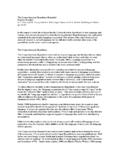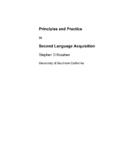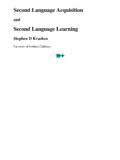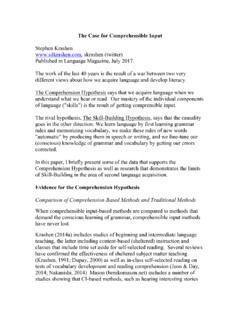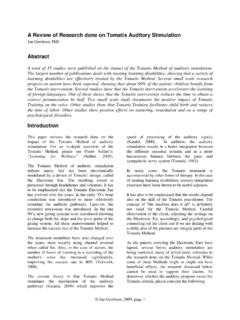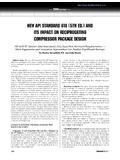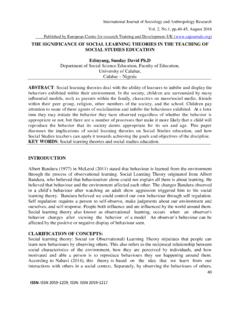Transcription of Free Voluntary reading: New Research, Applications, and ...
1 free Voluntary reading : new research , Applications, and Controversies Stephen KrashenPaper presented at the RELC conference, Singapore, April, 2004 Evidence for the Power of reading Evidence for the value of free Voluntary reading , or recreational reading , continues to accumulate. In the last few decades, evidence from several areas continues to show that those who do more recreational reading show better development in reading , writing, grammar and vocabulary, These results hold for first and second language acquisition, and for children and adults. Correlational studies Correlational studies have consistently shown that those who read more show more literacy development. I reviewed a number of these studies in detail in Krashen (1988) that relied on simple correlations. The results of such studies are reassuring and consistent with the view that reading results in language and literacy development, but of course correlation is not causality; it is quite possible that those who read better, as a result of more direct instruction in school, then go on to do more recreational reading .
2 More recent studies in second language acquisition make this interpretation less plausible: They consistently report a positive relationship between the amount of free reading done and various aspects of second and foreign language competence when the amount of formal instruction students had is statistically controlled ( Lee, Krashen, and Gribbons, 1996; Stokes, Krashen and Kartchner, 1998; Constantino, Lee, Cho and Krashen, 1997; S. Y. Lee, 2001). Case histories Case histories provide convincing verification of the power of reading . While not considered by some to be "scientific," they clearly are, because in many cases one can only attribute gains in literacy and language development to recreational reading ; there are no plausible confounds or alternative explanations for the obvious development that took place. In Krashen (1993) I described the cases of Malcolm X and Richard Wright, both of whom achieved very high levels of literacy, and both of whom attributed their literacy development to self-selected reading .
3 More recent studies include the Sweet Valley studies (Cho and Krashen, 1994, 1995a, 1995b): Adult second language acquirers made obvious and impressive progress in English as a second language simply by reading books from the Sweet Valley series, novels written for young girls (Sweet Valley Kids, Sweet Valley Twins) and teen-age girls (Sweet Valley High). Subjects did not attend ESL classes; their main source of English was the novels. "Maturation" and time in the US is also an unlikely factor here: All subjects had lived in the US for a considerable amount of time before starting their reading program, and had made little progress in English. For other cases in which recreational reading was the only plausible explanation for progress, see Krashen (2003). In-school free reading studies of in-school free reading are considered the gold standard for demonstrating the effectiveness of recreational reading , because they include a comparison group that engages in traditional instruction while the experimental group does free Voluntary reading .
4 There are slightly different models of in- school free reading (sustained silent reading , self-selected reading , extensive reading ) but they all have this in common: Students can read whatever they want to read (within reason) and there is little or no accountability in the form of book reports or grades. In my reviews of the research on in-school free reading (Krashen, 1993; 2001), I have concluded that with very few exceptions, students in these programs progress in reading at least as well as those in comparison groups, and often do considerably better. The most successful studies are those that last for longer than one academic year. Short-term studies produce less than spectacular results, most likely because it usually takes readers some time to settle in and find suitable reading material. The Comprehension Hypothesis Not only do we see triangulation among three different sources of evidence, all supporting the effectiveness of free reading , the reading Hypothesis is also consistent with the more general Comprehension Hypothesis, the hypothesis that we acquire language by understanding it.
5 The Comprehension Hypothesis finds support in several areas in second language acquisition, including beginning language teaching and intermediate language teaching: Students make better progress in classes that supply more "comprehensible input." I have also argued (Krashen, 1994, 2003) that other means of acquiring language are unlikely and without empirical support. Goodman (Furkey and Xu, 2003) and Smith (1994) have presented strong evidence that comprehension is the means by which we learn to read, providing evidence from sources very different from those cited here. Applications Sustained silent reading Perhaps the most common application of the reading Hypothesis in schools is the practice of sustained silent reading , or SSR. In SSR, a few minutes each day is devoted to recreational reading , usually between five and 15. As noted above, the research on SSR and related programs is quite positive. Pilgreen (2000) presents the principles of SSR and some helpful guidelines.
6 I focus here on just a few aspects of SSR. Do they really read during SSR? Some critics have claimed that SSR is merely a time for "pretend" reading , that many students simply flip pages and look at pictures. Von Sprecken and Krashen (1998) observed SSR classes in a middle school in the middle of the school year and reported that 90 percent of the students were engaged in reading . Their observations were confirmed in subsequent studies (Cohen, 1999; Herda and Ramos, 2001). Von Sprecken and Krashen also reported that more reading tended to take place in those classes in which more books were available, in which teachers read at the same time students read (see also Wheldall and Entwhistle, 1988), in which students were not required to bring their own books, and in which teachers made deliberate attempts to promote certain books. From observing SSR classes and from talking to numerous professionals, I have concluded that is more effective to do a little each day than to devote large segments of time once or twice a week to free reading .
7 The goal of SSR is to develop a taste for reading , to stimulate the once-reluctant reader to read more outside of school. Rather than forcing reading , and possibly making it distasteful, small doses are much more likely to work. It is not the actual time reading during SSR that counts, it is the desire to read more than counts. Thus SSR is not for very advanced readers. It is doubtful that readers of this paper will benefit by adding five to 15 minutes of free reading to their daily schedule. We have already developed a reading habit. studies confirm that those who participate in SSR programs read more on their own when the program is over (Pilgreen and Krashen, 1993) and one study showed that they continue to read more even years later (Greaney and Clarke, 1973). Self-selected reading Self-selected reading programs were popular in the United States in the 1950 s. In self-selected reading , the entire class period is devoted to recreational reading , except for a small amount of time devoted to teacher-student conferences in which teachers discuss what the child read, any problems that may have come up, and recommend additional reading .
8 Sheltered popular literature Sheltered popular literature exists only in my imagination. It is a suggestion for combining the advantages of literature teaching with the advantages of free Voluntary reading and attempts to solve a problem many second language readers have: A lack of familiarity with what is available. Sheltered popular literature is, first of all, a literature class with the same goals as any other literature class: The use of literature as a means of understanding the human condition, gaining insight into ethics, metaphysics, and culture. In sheltered popular literature, however, the focus is not on the "classics." Rather, the focus is on literature that second language students will find interesting and comprehensible. Depending on the age and background of the students, this could mean comic books, magazines, romance novels, mysteries, and newspapers. This "literature" would be discussed in class with the same seriousness we devote to the classics.
9 Our hope is that such a class will provide the same kind of cognitive development and reflective attitude that the study of classical literature provides. At the same time, it will inform the intermediate second language acquirer what reading material is available, and will, we hope, lead to a reading habit in the second language. Narrow reading An interesting hypothesis is that narrow, rather than broad or wide reading , is more efficient for second language acquisition. This means the work of one author, one genre or topic ( only detective novels). (I focus here on reading , but the idea of narrow input has been applied to listening as well; see Krashen, 1996; Rodrigo and Krashen, 1996; Dupuy, 1999). Narrow reading will be more interesting, by definition, because it is restricted to what the reader really wants to read. It will be more comprehensible, because the reader will already have a great deal of background knowledge, and will gain more background knowledge by reading .
10 Deep reading in any topic, it is hypothesized, will provide exposure to a tremendous amount of syntax and vocabulary that is used in other topics. Any technical field, for example, will use "subtechnical" vocabulary, words such as "function," "inference," "isolate," "relation," etc. (Cowan, 1974). There is some evidence supporting the narrow reading idea. Lamme (1976) found that good readers in English as a first language tended to read more books by a single author and books from a series, a result that many readers of this paper can identify with, former devotees of Nancy Drew, the Hardy Boys and Bobsey Twins. In addition, the Sweet Valley studies mentioned above are also an example of the efficacy of narrow reading . Of great interest is the fact that Sweet Valley readers eventually went on to read other authors. Sheltered popular literature introduces the second language reader to a range of interesting reading , in the hope that the reader will settle on one or two areas for narrow reading .
